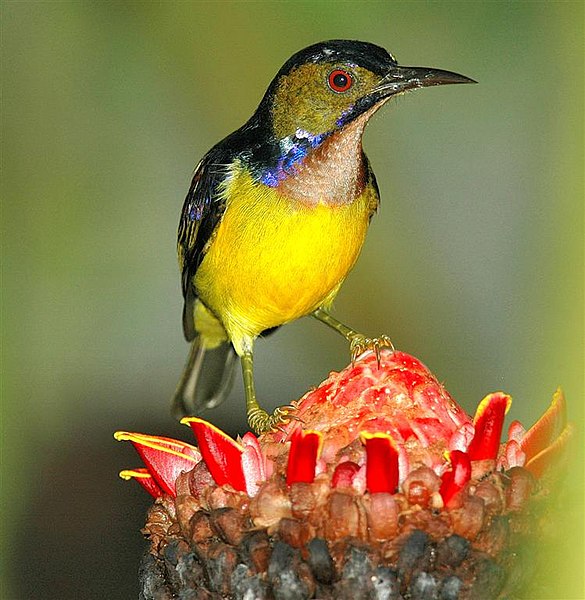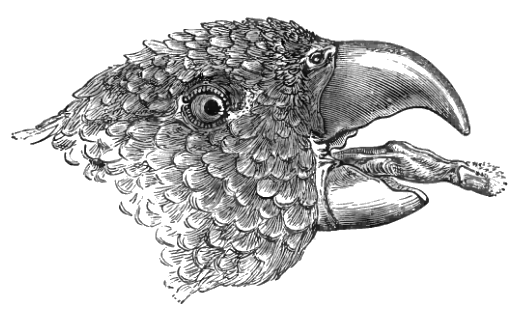 Sending flowers is a time-honored way of showing affection and concern, but did you know that your parrots and other feathered pets might appreciate a bouquet as well? I’m not suggesting actually having flowers delivered to your parrot (although I know several who have done that!), but rather that you consider edible flowers as a source of bird food and behavioral enrichment.
Sending flowers is a time-honored way of showing affection and concern, but did you know that your parrots and other feathered pets might appreciate a bouquet as well? I’m not suggesting actually having flowers delivered to your parrot (although I know several who have done that!), but rather that you consider edible flowers as a source of bird food and behavioral enrichment.
The Role of Flowers in Bird Diets
Flowers, buds and nectar figure heavily in the natural diets of many parrots, finches and softbills. In fact, lories and lorikeets are actually “floral specialists” (please see drawing of lorikeet tongue, adapted for nectar feeding). However, with the exception of nectar-mixes, flowers have largely been ignored by most pet keepers.
Flowers are also a major food item of several less commonly-kept softbills, including hummingbirds, sunbirds and the aptly-named flower-peckers. Ornithologists speculate that the brilliant colors of some species may have evolved to provide camouflage during feeding sessions in flowering trees.
Behavioral Stimulation
In addition to their nutritional value, flowers can provide important behavioral stimulation for parrots and other birds. Most parrots delight in tearing them to bits, and bud-covered fruit tree branches (apple, pear, plum etc.) will provide hours of entertainment for both pet and pet-owner. Finches, White-Eyes, Pekin Robins and other small birds will also poke about in flowers for insect treats, real or “imagined”, and may consume petals and nectar as well.
Purchasing Flowers
 Fortunately, it’s quite simple to incorporate flowers into your birds’ diets. Many bird-safe flowers are relished by people, and are available in food stores. In NYC markets, I’ve come across squash, zucchini, rose and daylily flowers (note: not all daylilies are safe for people or birds, so do not pick your own), as well as a number that I did not recognize. Korean, Chinese and Indian neighborhoods have proven especially rich flower-hunting grounds.
Fortunately, it’s quite simple to incorporate flowers into your birds’ diets. Many bird-safe flowers are relished by people, and are available in food stores. In NYC markets, I’ve come across squash, zucchini, rose and daylily flowers (note: not all daylilies are safe for people or birds, so do not pick your own), as well as a number that I did not recognize. Korean, Chinese and Indian neighborhoods have proven especially rich flower-hunting grounds.
Do not buy edible flowers from garden supply outlets or florists, as these will not have been slated for human consumption and would likely have been exposed to toxic chemicals.
Dried flowers specifically marketed as bird food are also a useful option. Goldenfeast’s Hibiscus and Chamomile
may be offered to a variety of parrots, finches and softbills.
Growing and Collecting Flowers for Your Birds
If the option is available to you, growing your own edible flowers is a great alternative to shopping.
Harvesting wild flowers is also possible, but you must be confident in your ability to identify the various species and have access to a pesticide-free collecting site. A field guide will be useful in this regard.
Common, Easy-to-Grow Edible Flowers
The following common flowers are readily accepted by many birds and can easily be grown or, in some cases, purchased at food markets. Do not buy flowers intended as food anywhere other than at a food market; please see above.
Daisy Marigold
Carnation Sunflower
Violet Zucchini Blossoms
Tulip Squash Blossoms
Elderberry Hibiscus
Impatiens Apple,Plum and Pear Blossoms
Further Reading
Further information on edible and poisonous flowers; written with people in mind but applicable to birds.
Eat Your Roses: a guide to 50+ edible flowers
Lorikeets image referenced from wikipedia and originally posted by Tatiana Gerus
Plain-Throated Sunbird image referenced from wikipedia and originally posted by Ltshears
 That Bird Blog – Bird Care and History for Pet Birds
That Bird Blog – Bird Care and History for Pet Birds





Just like you said…”flowers have largely been ignored by most pet keepers.” I have grape vines and other fruit bearing plants near or accessible to my flocks flight cages. It didn’t even occur to me to offer flowers. I have squash and zucchini plants growing now and offer the mature vegetables to my birds along with other grown vegetables and fruits. I will start offering the flowers (or at least try)! My birds are picky!
Would you be able to recommend reading/reference material that would, in detail, describe the natural diets of Macaw, Cockatoos, Conure, etc.? I quickly looked at Wikipedia to find information about diet but it’s a little to vague. “Macaws eat a variety of foods including fruits, palm fruits, nuts, seeds, leaves, flowers, and stems.”
Thank you!
Hello Adrian, Frank Indiviglio here.
Nice to hear from you again; glad you found the article useful. They may take some time to adjust, but even if they just trash the flowers there’ll be some benefit!
The absolute best reference for natural history is Joseph Forshaw’s Parrots of the World. I use the 1978 edition as it was written at a time when direct observation, field notes etc. were given great importance. I believe the 2 later editions include the text from the original, but I’ve not checked carefully. The book includes every described species and is the standard for ornithologists worldwide. Well written and makes for great reading as well. Any library should be able to get it for you; also, you might want to check prices on used copies of later editions, as will likely be less expensive than original.
He has also written a field guide, but it does not go into natural history in great detail.
Glad to see you are focusing on this…too many people ignore natural habits and rely on quick net-info these days.
Please let me know if you need any further information. Good luck, enjoy and please let me know what you think of the book.
Best regards, Frank Indiviglio.
my cockatoo LOVES flowers. one of the best is lavender, which i grow in the garden. her beak smells so good after ripping up some of the flowers. herbs are also enjoyed by her – especially rosemary.
a bonus is that she makes the house smell nice!
i offer flowers to my amazon also, but so far she hasn’t been interested.
Hello, Frank Indiviglio here.
Many thanks for sharing your observations and experience…very valuable to have such information, and most interesting as well. I’ll pass along your thoughts to others, and look forward to hearing from you again. I have a number of cockatoo articles posted…please let me know if you have need for any specific topics and I’ll send the links.
Please let me know if you need any further information. Good luck, enjoy and please keep me posted.
Best regards, Frank Indiviglio.